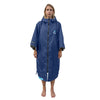In the face of COVID-19, everyone basically can only stay at home, but exercise can not stop, yoga and strength are good exercises.
Running and skipping are the two most common sports. But in real life, the popularity of running is very high, and there are fewer people skipping rope. You only need to raise your legs to run. Skipping requires at least one rope, and you also need certain skills, otherwise you can't jump smoothly. From the perspective of weight loss, both can play a good role in weight loss. But which weight loss effect is better?
Comparison of sports energy consumption
At a moderate exercise intensity (4MET), a person weighing 60 kg would run at a speed of about 6.5 km per hour for 40 minutes and consume about 160 kcal. In fact, some people can use brisk walking to complete the speed of 6.5km per hour, while others can do it by combining running and running. If the speed is increased to 8km per hour, it is a relatively intense high-intensity exercise (9MET). A 40-minute run can consume 360 kcal. After increasing to a speed of 10km per hour (11MET), a 40-minute run can consume approximately 450 kcal of heat. Of course, the caloric consumption of running is also related to factors such as slope, wind, and the venue (a flat track or a rugged mountain road).

Also taking a person weighing 60 kg as an example, skipping rope under 8MET exercise consumes about 240 kcal in half an hour and 320 kcal in 40 minutes. Compared with running at 8km per hour (9MET), the energy consumption is basically equivalent. 
Therefore, based on the theoretical energy consumption of sports, the energy consumption of the two in the same unit time is almost the same. But because running for 10 minutes more, the total energy consumption is relatively larger.
Information: What is MET (Metric Value)? MET (Metolite), also known as metabolic equivalent, refers to the consumption of 3.5 ml of oxygen per kilogram of body weight for one minute of activity. 1 to 3MET is low exercise intensity, 4 to 7MET is medium exercise intensity, and 7MET or more is high intensity exercise. The intensity of 1MET is equivalent to the metabolic level of an average adult when sitting in a quiet state.
Inference of actual energy consumption
First, the problem of "aerobic exercise requires at least half an hour to lose weight". Many fitness coaches will tell members that if you want to lose weight, you must use aerobic exercise for more than half an hour before the body starts to consume fat and it is considered to lose weight. However, according to the actual fitness case and some research data consulted, fat is not accurate to start the energy consumption rhythm 30 minutes after the start of exercise. It starts from a period of time after exercise (less than 30 minutes, some studies think about 20 Minutes) began to participate in energy supply, but it was not the main force of energy supply in the first half hour. After more than 30 minutes of exercise (not so accurate, there is a process of gradually increasing the proportion of fat energy supply), the proportion of fat energy supply gradually exceeds 50%, and it has become the main sports energy supply channel. Therefore, a half-hour skipping rope will have a difference in fat consumption efficiency compared to a 40-minute run. Because running takes 10 minutes more, obviously the fat reduction effect will be better. Assuming that the running time is extended to 1 hour, the difference between the two will be very obvious.
Second, the difficulty of actual exercise. In sports and fitness, as long as it involves jumping, it will pose a greater challenge to the heart and lungs. The actual feeling is that the heartbeat rises rapidly, as is the case with skipping rope. A person who can run for 40 minutes continuously may not be able to skip rope continuously for 40 minutes. In addition, rope skipping has basic skills and proficiency requirements. If the skill is poor and the proficiency is low, it will frequently stop and restart because the rope cannot smoothly pass through both feet, which objectively reduces the intensity of the exercise. Therefore, ordinary people need to complete 30 minutes of skipping, most of which are done by group. For example, 100 jumps per group, there will of course be rest between groups, the actual exercise time is not 30 minutes.
It can be seen that the actual total energy consumption for 40 minutes of running will also exceed the skipping of 30 minutes.
Regarding the question of jumping to test your cardiopulmonary abilities, friends who are interested can try these three actions and see how many of them you can complete in a row? Jump in place, rabbit squat (if you have a try try rabbit squat on the wider stairs), bobby jump.
The conclusion is that if you want to burn more calories, between the 40-minute long run and the 30-minute skipping rope, it is recommended to choose the former.
The effect of weight loss does not only depend on the exercise itself, or because we have selected a sport with a high fat loss efficiency, and investing enough aerobic exercise is a necessary condition to ensure successful weight loss. People who only run 60 minutes a week are better than those who skip rope five times a week for 30 minutes each time. Don't worry too much about the difference of ten minutes in one exercise time, stick to long-term regular exercise, and ensure that the number of exercises per week is more important!




















